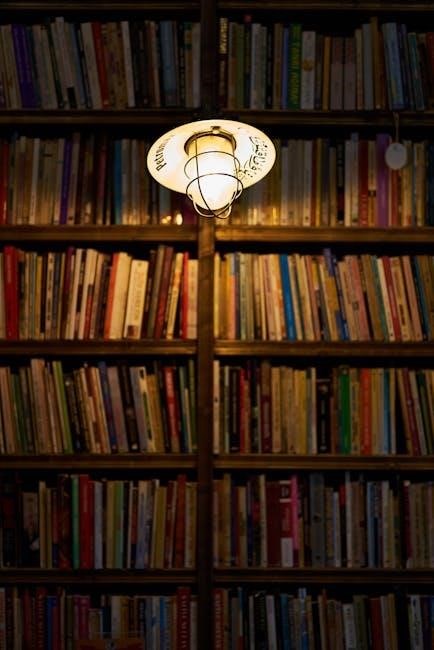This reading guide explores Anthony Doerr’s Pulitzer Prize-winning novel, All the Light We Cannot See, delving into its historical context, characters, and themes of hope, morality, and survival during WWII.

Overview of the Novel
All the Light We Cannot See is a historical fiction novel by Anthony Doerr, set during World War II. It intertwines the lives of two young protagonists, Marie-Laure, a blind French girl, and Werner, a German orphan, whose paths converge in the besieged town of Saint-Malo. The story explores themes of hope, survival, and morality amidst the devastation of war. Marie-Laure, gifted with a vivid imagination, navigates her world through touch and memory, while Werner, a scientifically inclined boy, is drawn into the Nazi regime. The novel also revolves around the mysterious Sea of Flames diamond, a cursed gemstone sought after by opposing forces. Doerr’s lyrical prose and non-linear storytelling weave together historical events, personal struggles, and the enduring power of human connection, creating a deeply emotional and thought-provoking narrative.
Author Background: Anthony Doerr
Anthony Doerr is a celebrated American author, born in 1973 in Cleveland, Ohio. Known for his lyrical and evocative prose, Doerr has established himself as a masterful storyteller. Before gaining acclaim for All the Light We Cannot See, he published several works, including short story collections like The Shell Collector and novels such as About Grace. His writing often explores themes of nature, science, and human resilience. Doerr’s work has been recognized with numerous awards, including the Pulitzer Prize for Fiction in 2015 for All the Light We Cannot See. His ability to weave historical narratives with emotional depth has resonated with readers worldwide, solidifying his place in contemporary literature.
Historical Context: World War II Setting
All the Light We Cannot See is set against the backdrop of World War II, a period marked by global conflict and profound human suffering. The novel vividly portrays the invasion of France by Nazi Germany, the occupation of Paris, and the eventual liberation of Saint-Malo. Historical events, such as the bombings and the resistance movements, are woven into the narrative, providing a stark yet intimate depiction of wartime life. The setting highlights the struggles of ordinary people caught in the chaos of war, including the French citizens fleeing occupied cities and the German soldiers grappling with the moral complexities of their roles. By grounding the story in real historical events, Doerr creates a compelling and immersive exploration of resilience, hope, and survival during one of the darkest periods in human history.

Characters in “All the Light We Cannot See”
The novel focuses on two main characters, Marie-Laure, a blind French girl, and Werner, a German orphan, whose lives intertwine during WWII, exploring themes of survival and humanity.
Marie-Laure LeBlanc: The Blind French Girl
Marie-Laure LeBlanc is a central character in All the Light We Cannot See, a blind French girl whose resilience and adaptability shape her journey through WWII. Born in Paris, she loses her sight at a young age and relies on her heightened senses and imagination to navigate the world. Her father, Daniel LeBlanc, crafts intricate models of their neighborhoods to help her “see” through touch. When the Nazi occupation forces them to flee Paris, Marie-Laure and her father find refuge in Saint-Malo with her reclusive great-uncle, Etienne. There, she discovers a mysterious diamond known as the Sea of Flames, which becomes a pivotal element in the story. Throughout the novel, Marie-Laure’s courage and determination inspire hope amidst the chaos of war.
Werner Pfennig: The German Orphan
Werner Pfennig is a central character in All the Light We Cannot See, a young German orphan growing up in the mining town of Zollverein with his sister, Jutta. Werner’s curiosity and talent for science and technology set him apart, earning him opportunities to escape his impoverished upbringing. He is admitted to the prestigious Schulpforta academy, where he is groomed for a role in the Nazi war effort. Despite his intellectual gifts, Werner struggles with the moral ambiguities of serving a regime he increasingly questions. His journey takes him across Europe, where he becomes entangled in the devastation of WWII. Werner’s story explores the tension between ambition, survival, and the search for humanity in a world consumed by conflict. His path ultimately intersects with Marie-Laure’s in Saint-Malo, where the consequences of his choices unfold.
Supporting Characters: Jutta, Frank Volkheimer, and Madame Manec
Jutta Pfennig, Werner’s older sister, serves as his moral compass, encouraging his curiosity while grappling with the harsh realities of their world. Frank Volkheimer, a towering German soldier, initially appears intimidating but reveals a compassionate side, becoming a complex figure in Werner’s life. Madame Manec, a fierce French Resistance leader, embodies courage and resilience, playing a pivotal role in the fight against Nazi occupation. Each character adds depth to the narrative, illustrating the human resilience and moral struggles that define the novel’s emotional landscape.
The Role of the Sea of Flames Diamond
The Sea of Flames diamond is a central plot device in All the Light We Cannot See, symbolizing both hope and destruction. This legendary gemstone is said to bring immense power to its owner but also carries a curse that destroys anyone who possesses it selfishly. Marie-Laure’s great-uncle, Daniel LeBlanc, hides the diamond in Saint-Malo, linking it to her survival and the broader narrative. Meanwhile, Werner’s obsession with the diamond reflects his internal struggle between ambition and morality. The diamond’s presence drives the plot forward, connecting the fates of Marie-Laure and Werner while highlighting themes of greed, sacrifice, and the enduring power of hope. Its elusive nature and the curse tied to it add layers of tension, underscoring the novel’s exploration of human choices and consequences during wartime.

Plot Structure and Narrative Style
The novel’s non-linear narrative weaves together the lives of Marie-Laure and Werner, using vivid imagery and short chapters to create a dynamic, fast-paced exploration of their intersecting paths during WWII.
Non-Linear Storytelling
The novel employs a non-linear narrative, jumping between different time periods and perspectives. This structure builds suspense and highlights the interconnectedness of Marie-Laure and Werner’s experiences during WWII;

The Intersection of Marie-Laure and Werner’s Stories
The lives of Marie-Laure and Werner intersect during the bombing of Saint-Malo, where their paths converge in a dramatic climax. Marie-Laure, hiding in her great-uncle’s house, and Werner, captured by French resistance fighters, find themselves connected through the chaos. Their stories reflect the broader themes of hope, survival, and moral choices. Marie-Laure’s journey symbolizes resilience and the power of imagination, while Werner’s trajectory reveals the complexities of human nature under duress. The Sea of Flames diamond serves as a symbolic link between them, representing both danger and transformation. Their meeting underscores the novel’s exploration of light and darkness, both literally and metaphorically, highlighting the enduring human spirit amidst war’s devastation. This intersection is central to the novel’s emotional and thematic impact.
Key Events: The Bombing of Saint-Malo
The bombing of Saint-Malo marks a pivotal moment in the novel, as Allied forces target the German-occupied walled city. Marie-Laure seeks refuge in a hidden cellar, while Werner, captured by French resistance fighters, is trapped in the chaos. The event intensifies the novel’s themes of survival and desperation. The destruction of Saint-Malo symbolizes the devastating impact of war on civilians and the environment. The bombing brings Marie-Laure and Werner’s stories to a climactic intersection, highlighting the randomness and brutality of conflict. This event underscores the novel’s exploration of light and darkness, as characters confront their mortality and the moral ambiguities of war. The bombing of Saint-Malo is a haunting reminder of the human cost of warfare and the enduring hope for survival amidst destruction.

Themes and Symbolism

The novel explores themes of hope, survival, and morality, intertwined with symbolism like light and blindness. These elements highlight human resilience and the moral complexities of wartime, offering profound insights into existence and the enduring power of hope amidst destruction.
Hope and Survival in Wartime
Hope and survival are central themes in All the Light We Cannot See, as both Marie-Laure and Werner navigate the devastating backdrop of WWII. Despite the chaos and loss, the novel illustrates how hope sustains individuals, offering a beacon of light in darkness. Marie-Laure’s resilience and Werner’s quest for redemption exemplify the human spirit’s capacity to endure. The story underscores how hope is not merely optimism but a vital force that drives survival, even in the face of overwhelming adversity. Through their journeys, Doerr shows that hope can transform suffering into a testament of human strength and the enduring possibility of a better future. This theme resonates deeply, reminding readers of the power of hope in the most desperate times.
Morality and Human Nature
All the Light We Cannot See explores the complexities of morality and human nature through its characters’ choices and struggles during WWII. Werner’s journey, in particular, delves into the moral dilemmas of complicity and resistance. His internal conflict between curiosity and conscience highlights the tension between individual agency and societal expectations. Marie-Laure’s character, meanwhile, embodies resilience and kindness, showcasing the enduring power of compassion even in the face of adversity. The novel also examines the duality of human behavior, where characters like Frank Volkheimer and Madame Manec reveal both the brutality and the humanity that coexist in wartime. Through these portrayals, Doerr raises profound questions about the nature of right and wrong, encouraging readers to reflect on the ethical choices people face in extreme circumstances. The novel ultimately suggests that human morality is shaped by both individual will and the forces of history.
The Power of Science and Knowledge
All the Light We Cannot See highlights the transformative power of science and knowledge through Werner Pfennig’s fascination with technology and Marie-Laure’s father’s scientific endeavors. Werner’s early curiosity about radios and engineering not only shapes his identity but also leads him into the moral complexities of military innovation. His journey illustrates how knowledge can be both empowering and destructive, depending on its application. Similarly, Marie-Laure’s father uses scientific principles to create a model of their neighborhood, aiding her navigation despite her blindness. The novel underscores the dual nature of science—its potential to enlighten and uplift, as well as its capacity to perpetuate harm when misused. Through these characters, Doerr explores how science and knowledge intersect with human values, emphasizing their role in shaping individual and collective destiny during times of crisis. The novel ultimately celebrates the enduring spirit of curiosity and discovery.
Blindness as a Metaphor
Marie-Laure’s blindness serves as a profound metaphor in All the Light We Cannot See, symbolizing inner light, intuition, and the unseen forces that guide humanity. Despite her physical inability to see, Marie-Laure experiences the world through touch, sound, and imagination, emphasizing the idea that true vision transcends physical sight. Her father’s intricate model of Paris, for instance, allows her to “see” through tactile exploration, highlighting the adaptability of the human spirit. Similarly, Werner’s spiritual blindness amidst the chaos of war contrasts with Marie-Laure’s clarity of purpose, underscoring the theme of moral and emotional sight. The novel suggests that blindness, both literal and metaphorical, can lead to deeper understanding and connection, offering a powerful commentary on perception, resilience, and the light within. This metaphor enriches the narrative, inviting readers to reflect on how they navigate their own darkness and seek illumination.

Literary Devices and Style

Doerr’s masterful use of imagery, foreshadowing, and symbolic elements creates a vivid, layered narrative that explores light and darkness, both literally and metaphorically, enriching the reader’s experience.
Imagery and Descriptive Language
Anthony Doerr’s vivid imagery and descriptive language immerse readers in the world of All the Light We Cannot See. Through rich, evocative prose, he paints landscapes, emotions, and moments with precision. Marie-Laure’s blindness is juxtaposed with her heightened sense of touch and hearing, creating a unique sensory experience. Doerr’s descriptions of light and darkness serve as metaphors for hope and despair, central themes of the novel. The portrayal of Saint-Malo’s cobblestone streets and the glow of the Sea of Flames diamond exemplify his ability to craft visually stunning scenes. His writing style, often poetic and lyrical, enhances the emotional depth of the narrative, allowing readers to connect deeply with the characters and their journeys. This masterful use of imagery transforms the story into a cinematic experience, making the novel a feast for the imagination.
The Role of Radio and Communication
Radio and communication play pivotal roles in All the Light We Cannot See, serving as tools for connection and propaganda. Werner’s fascination with radios leads him to engineer communication devices for the German army, highlighting the dual-edged nature of technology. Radio broadcasts deliver crucial information, spreading hope or fear depending on the source. For Marie-Laure, radio broadcasts from her father and the French Resistance offer solace and resistance. The Sea of Flames diamond’s hidden broadcasts further symbolize the power of communication in both uniting and dividing. Doerr uses radio as a metaphor for the flow of knowledge and ideas, illustrating how it can be both a lifeline and a weapon. This theme underscores the novel’s exploration of human connection and the impact of information in wartime, emphasizing the enduring power of voice and communication.
Foreshadowing and Symbolism
Foreshadowing and symbolism are masterfully woven into All the Light We Cannot See, enriching its narrative depth. The Sea of Flames diamond symbolizes both transcendence and destruction, its presence foreshadowing pivotal events. Marie-Laure’s blindness serves as a metaphor for inner sight and resilience, contrasting with Werner’s literal and moral vision. The recurring imagery of waves and the ocean foreshadows the convergence of their paths in Saint-Malo. Radio broadcasts and the diamond’s myths act as symbolic threads, connecting characters across time and space. Doerr’s use of light and darkness symbolizes hope and despair, reflecting the characters’ internal journeys. These elements not only enhance the story but also underscore its exploration of survival, morality, and the enduring power of human connection in the face of war. Foreshadowing and symbolism thus become essential tools for unraveling the novel’s layered meaning.

Reading Guide and Analysis
This section provides strategies for engaging with the novel, including thematic analysis and reflection on moral dilemmas, helping readers uncover the depth of Doerr’s storytelling and its universal themes.
Preparation for Reading: Historical and Cultural Context
To fully appreciate All the Light We Cannot See, readers should understand the historical backdrop of World War II, particularly the experiences of occupied France and Nazi Germany. The novel vividly portrays life under German occupation, highlighting the struggles of civilians like Marie-Laure and the moral complexities faced by characters like Werner. Familiarity with key events, such as the invasion of France, the French Resistance, and the bombing of Saint-Malo, enriches the reading experience. Culturally, the novel explores the clash between French and German identities, reflecting the tension of the time. Understanding these contexts helps readers grasp the characters’ motivations and the broader themes of survival, hope, and morality. By grounding the story in its historical and cultural setting, Doerr creates a deeply immersive and emotionally resonant narrative.
Reading Strategies: Identifying Themes and Motifs
When reading All the Light We Cannot See, it’s essential to pay attention to recurring themes and motifs, such as hope, survival, and the interplay of light and darkness. These elements weave together to create a rich narrative tapestry. Readers should note how Doerr uses imagery and symbolism, such as the Sea of Flames diamond, to represent broader ideas like greed and redemption. The motif of radio waves and communication highlights the power of connection in a fragmented world. Encourage close reading to track these themes and motifs, observing how they evolve and intersect throughout the story. Additionally, consider how the characters’ experiences reflect universal human struggles, such as morality, curiosity, and resilience. By actively identifying and analyzing these elements, readers can gain a deeper understanding of the novel’s emotional and philosophical depth.
Post-Reading Reflection: Discussing Moral Dilemmas
After finishing the novel, readers should reflect on the moral dilemmas faced by characters like Werner and Marie-Laure. These dilemmas, shaped by the harsh realities of war, challenge notions of right and wrong. Werner’s journey, for instance, raises questions about complicity and the choices individuals make under oppressive systems. Marie-Laure’s story highlights resilience and the ethical decisions required to survive. Discussing these moral complexities encourages readers to consider how they might act in similar circumstances. The novel also invites reflection on broader human values, such as compassion, forgiveness, and the consequences of one’s actions. By engaging with these themes, readers can deepen their understanding of the novel’s exploration of human nature and the ethical challenges of wartime. This reflection fosters meaningful conversations about morality, empathy, and the enduring impact of choices made during times of crisis.
All the Light We Cannot See leaves a profound impact, weaving a tale of hope, survival, and human resilience during WWII. Its haunting beauty lingers, inspiring reflection on morality, science, and the enduring power of light in darkness.
The Lasting Impact of the Novel
All the Light We Cannot See has left an indelible mark on literature, earning Anthony Doerr the Pulitzer Prize in 2015. Its intricate narrative and vivid imagery captivate readers, offering a profound exploration of human resilience during WWII. Themes of hope, morality, and the interplay of light and darkness resonate deeply, making the novel a timeless classic. The story’s emotional depth and historical significance ensure its continued relevance, sparking discussions on survival, science, and the human condition. The novel’s success lies in its ability to weave personal narratives into the broader tapestry of war, creating a compelling and unforgettable reading experience.
